|
Washington, DC, January 17, 2013 –
The poster for the blockbuster movie Zero Dark Thirty features black lines of redaction over the title, which unintentionally illustrate the most
accurate take-away from the film - that most of the official record of the hunt for Osama bin Laden is still shrouded in secrecy, according to the National
Security Archive's ZD30 briefing book, posted today at www.nsarchive.org. The U.S. government's recalcitrance over
releasing information directly to the public about the twenty-first century's most important intelligence search and military raid, and its decision
instead to grant the film's producers exclusive and unprecedented access to classified information about the operation, means that for the time being – for
bad or good – Hollywood has become the public's "account of record" for Operation Neptune Spear.
As often happens when the government declines on secrecy grounds to provide an authoritative account of a controversial event, leaked, unauthorized and
untrustworthy versions rush to fill the void. In this extraordinary case, a Hollywood motion picture, with apparent White House, CIA, and Pentagon blessing and despite its historical inaccuracies, is now the closest thing to the official story behind the pursuit of bin Laden.
Zero Dark Thirty
's screenwriter, Mark Boal, has claimed that the film is "a movie not a documentary" and should not be treated as history. But the U.S. government's widely reported
support and its official silence about the raid have made Zero Dark Thirty (the military designation for 12:30 AM) more than a
mere thriller. Today, in an effort to balance the record, to the extent currently possible, the National Security Archive has collected, posted, and
analyzed in one Electronic Briefing Book all of the available official documents on the mission to kill the notorious al-Qaeda leader. The documents
include:
Until the White House, Department of Defense, and Central Intelligence Agency declassify – or Congress demands – their accounts and documentation of
Operation Neptune Spear, the official documents presented here – supplemented by leaks, unauthorized disclosures, and this film – will be the public's
attenuated record of the hunt for, and death of, Osama bin Laden.
THE DOCUMENTS
Document 1
"Usama Bin Laden: Islamic Extremist Financer," 1996, CIA biographical sketch, Unclassified.
Perhaps the earliest publicly available document on Osama bin Laden, this CIA biographical sketch describes him as having "joined the Afghan resistance
movement in 1979," and as "one of the most significant financial sponsors of Islamic extremist activities in the world."
Document 2
"FBI Wanted Poster," June 1999, revised November 2001, Federal Bureau of Investigation, Unclassified.
This "FBI Ten Most Wanted Fugitive" poster of bin Laden, now labeled "deceased," declares that he is wanted for the murder of U.S. nationals outside the
United States, conspiracy to murder U.S. nationals outside the United States, and an attack on a federal facility resulting in death. In addition to the
$25 million offered for bin Laden's apprehension or capture by the Department of State's "The Rewards For Justice Program," an additional $2 million was
offered by the Airline Pilots Association and the Air Transport Association program.
Document 3
"SUBJECT: Recommendation for Continued Detention Under DoD Control (CD) for Guantanamo Detainee, ISN US9SA-000063DP (S) [Muhammad Al-Qahtani]," October
30, 2008,
The Torture Archive
, published by WikiLeaks on April 25, 2011, on Department of Defense Headquarters, Joint Task Force Guantanamo U.S. Naval Station, Cuba, Secret NoForn
20331030.
Zero Dark Thirty
opens with the torture of a character named Ammar, who provides information which eventually leads to the identity of bin Laden's courier, Abu Ahmed
al-Kuwaiti. Ammar was likely a composite of at
least two al-Qaeda members, Mohammed al-Qahtani and Hassan Ghul. Al-Qahtani, who has been referred to as the "20th hijacker" of September 11, told
interrogators that he received computer training from al-Kuwaiti. Khalid Sheikh Mohammad – who is also referenced in the film – instructed al-Kuwaiti to
train al-Qahtani how to send emails. The document reports that al-Kuwaiti "served as a courier" for Khalid Sheikh Mohammad in Kandahar.
The document also reports that Hassan Ghul – who was captured in Iraq and was believed to be taken to a prison in Pakistan – told interrogators that
al-Kuwaiti "travelled with UBL." An analyst noted in the file that "al-Kuwaiti was seen in Tora Bora and it is possible al-Kuwaiti was one of the
individuals [al-Qahtani] reported accompanying UBL in Tora Bora prior to UBL's disappearance."
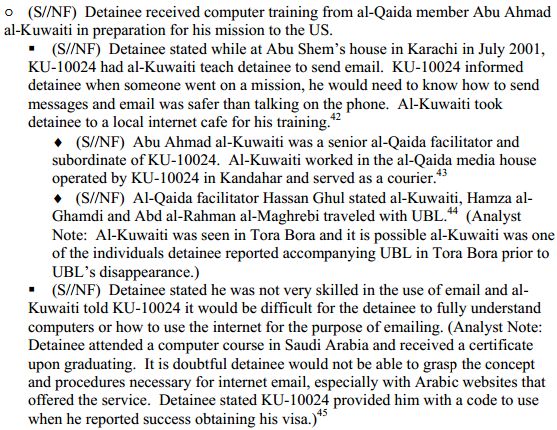
Excerpt from Document 3.
Al-Qahtani was interrogated by the FBI and military using aggressive techniques, including forced nudity and 48 days of severe sleep deprivation, approved
by Secretary of Defense Donald Rumsfeld and described in the " First Special Interrogation Plan." According to the May
30, 2005, Office of Legal Counsel Convention Against Torture memorandum, the team
interrogating Ghul in Pakistan sought "authorization to use dietary manipulation, nudity, water dousing, and abdominal slap." While the specific techniques
used during the interrogation are in question, Senators Dianne Feinstein and Carl Levin
claim
that Ghul provided the information that led to al-Kuwaiti prior to his torture; these claims are based upon a 6,000-page Senate Intelligence
Committee Report on torture that has not been released to the public. The same Department of Justice internal memo reports that the CIA waterboarded Khalid
Sheikh Mohammed 183 times.
The May 7, 2004 CIA Inspector General's Report on "Counterterrorism Detention and
Interrogation Activities," concluded, "The CTC Detention and Interrogation Program has resulted in the issuance of thousands of individual intelligence
reports and analytic products supporting the counterterrorism efforts of U.S. policymakers and military commanders. The effectiveness of particular
interrogation techniques in eliciting information that might not otherwise have been obtained cannot be so easily measured, however."
This intelligence work was chronicled in a September 2010 CIA memo entitled "Anatomy of a Lead." The CIA responded to a National Security Archive Mandatory
Declassification Review request for this memo by claiming that it could not confirm its existence, because if the memo did exist, it "would be contained in
operational files" and therefore not subject to declassification requests.
Document 4
"RQ-170 Sentinel" Fact Sheet, undated, United States Air Force, Unclassified.
Source:
http://www.af.mil/information/factsheets/factsheet_print.asp?fsID=16001&page=1
This brief fact sheet describes the RQ-170 Sentinel, the stealth drone that provided intelligence, surveillance and reconnaissance support during the raid
of bin-Laden's compound. According to the fact sheet, the RQ-170, known colloquially as "The Beast of Kandahar" and developed by Lockheed Martin, is manned
by the Air Combat's 432nd Wing at Creech Air Force Base, Nevada, and the 30th Reconnaissance Squadron at Tonapah Test Range, Nevada.
Document 5
"Navy SEAL Card Identifying Members of Abbottabad Compound," Undated, published by Peter Bergen and Courtesy of Christina Lamb, Unclassified.
These two images comprise the front and back of a card carried by the U.S. Navy Seals who raided the Abbottabad compound. The images depict members of the
bin Laden and al-Kuwaiti families.
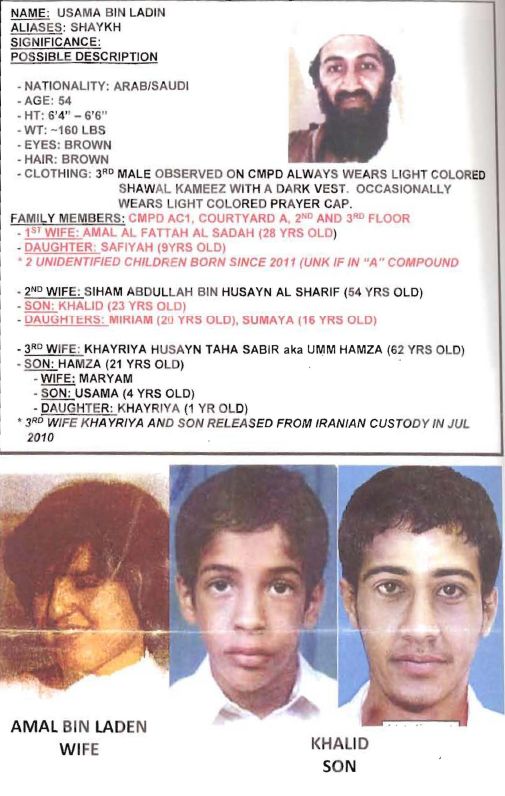
Document 5 (front).
Document 6
"P050111PS-0210," May 1, 2011, this photograph belongs to The White House flickr photostream and is part of a collection of 10 photographs from May 1, 2011, Unclassified.
Source:
http://www.flickr.com/photos/whitehouse/5680724572/in/set-72157626507626189
Slideshow from Whitehouse Flickr set. |
This photograph, snapped by White House photographer Pete Souza in a room adjacent to the White House Situation Room, captures President Obama and his
national security team as they react to Operation Neptune Spear. Seated, clockwise, are: Vice President Joe Biden; President Barack Obama; Brigadier
General Marshall B. "Brad" Webb, Assistant Commanding General, Joint Special Operations Command; Deputy National Security Advisor Denis McDonough;
Secretary of State Hillary Rodham Clinton; and Secretary of Defense Robert Gates. Standing, from left, are: Admiral Mike Mullen, Chairman of the Joint
Chiefs of Staff; National Security Advisor Tom Donilon; Chief of Staff Bill Daley; Tony Blinken, National Security Advisor to the Vice President; Audrey
Tomason, Director for Counterterrorism on the NSC staff; John Brennan, Assistant to the President for Homeland Security and Counterterrorism; Director of
National Intelligence James Clapper, and "John", a CIA analyst who was the first person to put
in writing that the agency might have an actionable lead on bin Laden. Note that a classified document in front of Secretary of State Hillary Clinton has
been obscured.
Document 7
"Tactical Site Exploitation and Cache Search Operations," May 2007, Center for Army Lessons Learned, Handbook No. 07-26, Unclassified, For Official Use
Only.
This 91-page FOUO manual describes the methods that U.S. soldiers involved in tactical site exploitation (TSE) use "to ensure that documents, material, and
personnel are identified, collected protected, and evaluated in order to facilitate follow-on actions." As portrayed in the film, TSE teams travel with
permanent markers, zip-lock bags, shoe tags, flashlights, gloves, digital voice recorders, and digital cameras. Upon the soldiers' return to base, they are
instructed to "Collect all TSE material and cameras," "sketch OBJ [objective] on [a white] board with rooms numbered," and "deconflict stories, TSE bags,
and photos, and go over sequence."
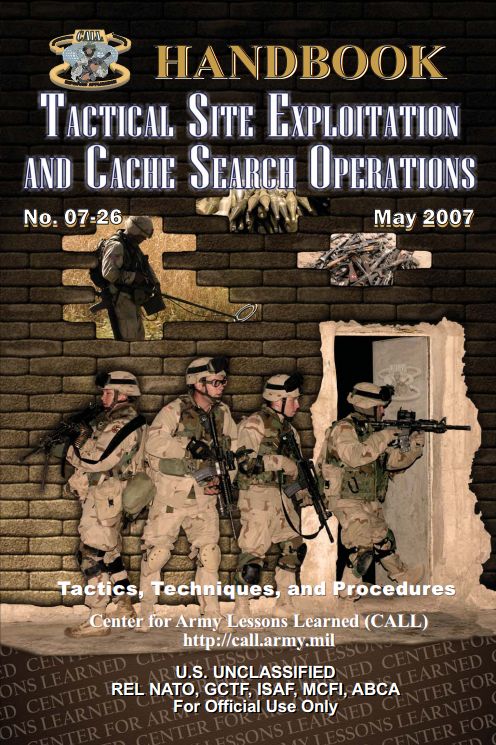
Front cover of Document 7.
Document 8
"Subject: FEDEX," May 2, 2011, 2:02 AM and related emails, released in response to an Associated Press FOIA request to the Department of Defense,
Secret.
Hours after bin Laden was killed, Rear Admiral Charles Gaouette, Deputy Commander of U.S. Navy's Fifth Fleet, emailed Samuel Perez, Rear Admiral of the
strike group including the USS Carl Vinson, tersely asking, "Sam, Any news on the package for us?" The "package" was the body of Osama bin Laden. At 2:02
AM at a location somewhere in the North Arabian Sea, Rear Admiral Perez emailed back: "Sir, FEDEX delivered the package. Both trucks are safely enroute
home base."
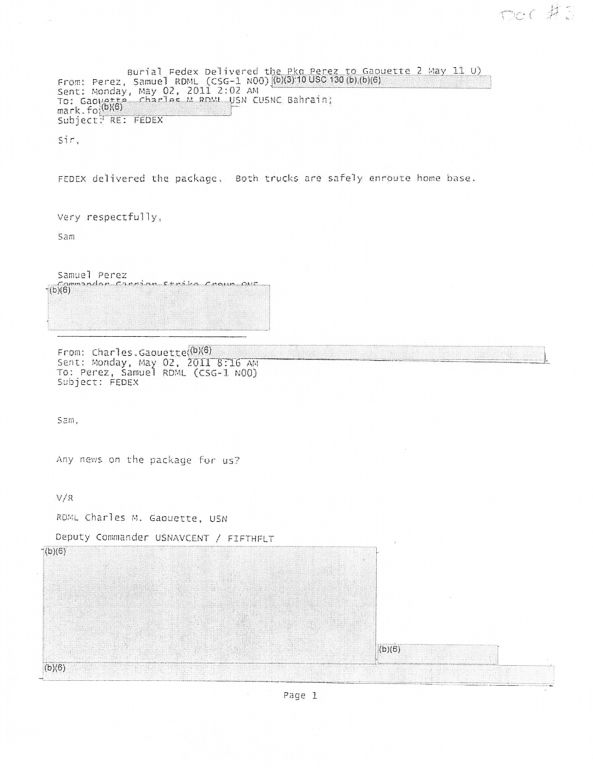
Excerpt from Document 8.
To date, these emails (ten in all) relating to bin Laden's burial at sea are the only documents of his death released through FOIA. After the raid, the
Department of Defense changed its FOIA policy
so that all requests relating to the raid are now handled by the Secretary of Defense's FOIA office, not the DOD components which created and maintain the
documents, as is the usual DOD FOIA policy.
Other emails describe the procedures taken to ensure the secrecy of the burial. In one email, Gaouette wrote, "The paucity of documentary evidence in our
possession is a reflection of the emphasis placed on operational security during the execution of this phase of the operation." Another email asked "if
soldiers knew what was occurring or who the burial was for." "No" was the eventual response.
An email addressed to Chairman of the Joint Chiefs of Staff Admiral Michael Mullen describes the burial at sea: "Traditional procedures for Islamic burial
was [sic] followed. The deceased's body was washed (ablution) then placed in a white sheet. The body was placed in a weighted bag. A military officer read
prepared religious remarks, which were translated into Arabic by a native speaker. After the words were complete, the body was placed on a prepared flat
board, tipped up, whereupon the deceased's body slid into the sea."
Document 9
"Press Briefing by Senior Administration Officials on the Killing of Osama bin Laden," May 2, 2011, 12:03 AM EDT, http://www.whitehouse.gov, Unclassified.
Source:
http://www.whitehouse.gov/the-press-office/2011/05/02/press-briefing-senior-administration-officials-killing-osama-bin-laden
The first White House briefing on the UBL raid is the most comprehensive official account of Operation Neptune Spear to date. The briefing is a conference
call with an unspecified number of unnamed senior administration officials, one of whom notes that between March and April of 2011 President Obama held "no
fewer than five National Security Council meetings" discussing the intelligence surrounding what would become the UBL raid. The briefing also paints the
raid as a well-integrated, multi-year effort comprising work done by "(o)fficers from the CIA, the NGA, [and] NSA." Specific physical characteristics of
the compound in Abbottabad are given, including reports that the inhabitants burned their trash, and that the compound was "valued at approximately $1
million but has no telephone or Internet service connected to it." The briefing also provides a scripted narrative of the firefight resulting in bin
Laden's death, which will put al-Qaeda "on a path of decline that will be difficult to reverse." The briefing closes on a note of continued vigilance,
warning that "in the wake of this operation, there may be a heightened threat to the homeland and to U.S. citizens and facilities abroad."
Document 10
"DOD Background Briefing with Senior Defense Officials from the Pentagon and Senior Intelligence Officials by Telephone on U.S. Operations Involving
Osama Bin Laden," May 2, 2011, 11:30 AM EDT, www.defense.gov, Unclassified.
Source: http://www.defense.gov/transcripts/transcript.aspx?transcriptid=4818
The first Department of Defense briefing on the UBL raid provides the official narrative of bin Laden's burial at sea and discusses the confidence level
that it was indeed Osama bin Laden living at the compound. A senior intelligence official states that bin Laden was "visually identified on the scene by
those who conducted the raid. Also on the scene, one of the women on the compound who we assessed to be one of his wives identified him by name as Osama
bin Laden." The same official explains that, given the large amount of documentation collected at the compound, "a task force is being set up at CIA" to
assess the materials. A senior defense official claims that "(t)he American team engaged in a firefight, and as indicated last night, Osama bin Laden did
resist … He and some other male combatants on the target appeared to use -certainly did use women as shields." This erroneous claim is repeated later
in the day at a White House press briefing, and only later retracted under scrutiny. Slides of the compound were provided at the end of the briefing, and
are the only official images of the compound released to date. The slides include a map of Pakistan, and several NGA images
of the Abbottabad compound - in 2005, pre- and post-construction, in 2011, and in a conceptual illustration.
Document 11
"Press Briefing by Press Secretary Jay Carney and Assistant to the President for Homeland Security and Counterterrorism John Brennan," May 2, 2011,
2:00 PM EDT, http://www.whitehouse.gov, Unclassified.
Source:
http://www.whitehouse.gov/the-press-office/2011/05/02/press-briefing-press-secretary-jay-carney-and-assistant-president-homela
The second White House press briefing was conducted by Press Secretary Jay Carney and John Brennan, Assistant to the President for Homeland Security and
Counterterrorism. The discussion focuses primarily on the reliability and strength of U.S. relations with the Pakistani government, the nature of the
documents seized by the SEAL team at the Abbottabad compound, and what documentation would be released to the public. After being asked if and when photos
of bin Laden would be provided to the public, Brennan states, "We have released a tremendous amount of information to date. We are going to continue to
look at the information that we have and make sure that we are able to share what we can, because we want to make sure that not only the American people
but the world understand exactly what happened." Mr. Brennan reiterates the Department of Defense claim of women being used as shields, and states that
"(t)here was family at that compound, and there was a female who was in fact in the line of fire that reportedly was used as a shield to shield bin Laden
from the incoming fire." Mr. Brennan followed this statement by saying "I think it really just speaks to just how false his narrative has been over the
years. And so, again, looking at what bin Laden was doing hiding there while he's putting other people out there to carry out attacks again just speaks to
I think the nature of the individual he was."
Document 12
"Press Briefing by Press Secretary Jay Carney," May 3, 2011, http://www.whitehouse.gov, Unclassified.
Source:
http://www.whitehouse.gov/the-press-office/2011/05/03/press-briefing-press-secretary-jay-carney-532011
The third White House briefing on the raid reiterates the Department of Defense narrative of Osama bin Laden's burial at sea. After being questioned about
the specifics surrounding bin Laden's death, Press Secretary Carney remains murky on precisely how bin Laden resisted the invasion and why he was
subsequently shot. Carney walks back John Brennan's inaccurate comments from the previous day, and states that a woman was not used as bin Laden's shield.
He also confirms that bin Laden was not armed during the firefight. Carney confirms Brennan's statements from the day before regarding when and how
official information would be provided to the public, stating that the documentation surrounding the raid is of higher sensitivity than anything the
government has produced in a long time, and that the administration "will continue to review that and make decisions about the appropriateness of releasing
more information as that review continues on." When pressed on the issue of releasing photos, and reminded that the Bush administration had released
photographs of Uday and Qusay Hussein (the U.S. government had also released photos of Abu
Musab al-Zarqawi, the leader of al-Qaeda in Iraq), Carney reiterates that heightened sensitivities surround the photographs of the deceased al-Qaeda
leader.
Document 13
"Daily Press Briefing," May 3, 2011, www.state.gov, Unclassified.
Source: http://www.state.gov/r/pa/prs/dpb/2011/05/162476.htm
At this Department of State press briefing, spokesman Mark C. Toner broadly discusses the U.S.-Pakistani relationship in the wake of the UBL raid, with the
overall sentiment that despite the "trust deficit," continued cooperation with Pakistan is essential in the war on violent extremists.
Document 14
"Osama bin Laden's Death: Implications and Considerations," May 5, 2011, Congressional Research Service, obtained by Secrecy News
, Unclassified.
Source: http://www.fas.org/sgp/crs/terror/R41809.pdf
This report, produced by CRS, but not released to the public as a matter of Congressional policy, uses open source intelligence to brief members of
Congress on the "multi-faceted topic" of bin Laden's death, focusing primarily on the ways that it could affect future U.S. national security and foreign
policy. The section on Congressional Notification states that the raid was a "Title 50" operation, which means that the president chose to conduct it as a
covert operation and was nominally the mission's commander, although it was carried out by Vice Admiral William McRaven. The Congressional "Gang of Eight"
was briefed on the plans ahead of the raid, which is consistent with the legal requirement that they be advised of Presidential Findings in connection with
covert actions.
Document 15
"Background Briefing with Senior Intelligence Official at the Pentagon on Intelligence Aspects of the U.S. Operation Involving Osama Bin Laden," May 7,
2011, www.defense.gov, Unclassified.
During this background briefing, a senior intelligence official states that the UBL raid produced "the single largest collection of senior terrorist
materials ever. We are currently reviewing materials retrieved from bin Laden's compound in Abbottabad." The materials indicated that bin Laden was still
al-Qaeda's tactical director and was much more than a figurehead. Additional information was provided on the task force that was constituted to analyze the
materials, which included the CIA, the Department of Homeland Security, the Defense Intelligence Agency, the Office of the Director of National
Intelligence, the FBI, the National Media Exploitation Center, the National Counterterrorism Center, the National Geospatial-Intelligence Agency, the
National Security Agency, and the Department of the Treasury. The briefing also included segments of five video clips discovered during the raid, from which audio had been
removed, to reinforce evidence of bin Laden's continued terrorist activities and to add credence to the confidence level that it was bin Laden living at
the compound.
Document 16
"Letters from Abbottabad: Bin Ladin Sidelined?" May 3, 2012, Department of Defense, Department of the Army, The Combatting Terrorism Center at West
Point, Unclassified.
Source: http://www.ctc.usma.edu/wp-content/uploads/2012/05/CTC_LtrsFromAbottabad_WEB_v2.pdf
One year after Operation Neptune Spear, West Point's Combatting Terrorism Center released translations of 17 documents seized during the raid. The
accompanying report notes that the 17 documents – 175 pages in the original Arabic and 197 of English translation – "offer unique insights" that would be
most beneficial when contextualized with more information, and that it is CTC's hope that "the release of these documents will not be the last word on the
subject but simply the opening foray into a much larger academic debate and discussion which will further our understanding of al-Qa`ida and terrorism more
broadly." The letters, dating from September 2006 through April 2011, are authored by top al-Qaeda leaders, including Abu Yahya al-Libi, Adam Yahya Gadahn,
Mukhtar Abu al-Zubayr, and Osama bin Laden, and notably highlight bin Laden's frustration with his inability to control his jihadist "brothers" acting
throughout the region, whom he encouraged to discontinue attacks that cause Muslim civilian casualties. The letters also indicate that bin Laden thought
that "apostate" Muslim rulers also constituted "enemies" of Islam, along with their presumed Western backers.
Document 17A
"Subject: FW: Schedule for Kathryn Bigelow Meetings," Internal CIA Memo, July 14, 2011, Secret, and related CIA and DOD records with bin Laden
filmmakers resulting from Judicial Watch v. U.S. Department of Defense (No. 1:12-cv-00049), filed January 21, 2012, Secret, Confidential,
Unclassified.
Source: http://www.judicialwatch.org/press-room/press-releases/judicial-watch-obtains-4-to-5-inch-stack-of-overlooked-cia-records-detailing-meetings-with-bin-laden-filmmakers/
In response to a FOIA lawsuit, the White House, CIA and DOD released 461 pages of documents to Judicial Watch detailing meetings with -and preferential
treatment toward- Zero Dark Thirty director Kathryn Bigelow and screenwriter Mark Boal. One email from CIA spokesperson Marie Harf explained the
preferential treatment: "I know we don't pick favorites but it makes sense to get behind a winning horse … Mark and Kathryn's movie is going to be
the first and the biggest."
The most substantive of the documents is the sixteen-page set of minutes of a July 15, 2011, meeting Under Secretary of Defense for Intelligence Michael
Vickers held with Bigelow and Boal. One of the many disclosures Vickers reveals is that the biggest naysayer on the possibility that bin Laden was in
Abbotabad was nicknamed "Mr. Forty Percent," Morrell was at 60 percent certainty, others including members of the National CounterTerrorism Center and
Vickers were in the "80 percent camp."
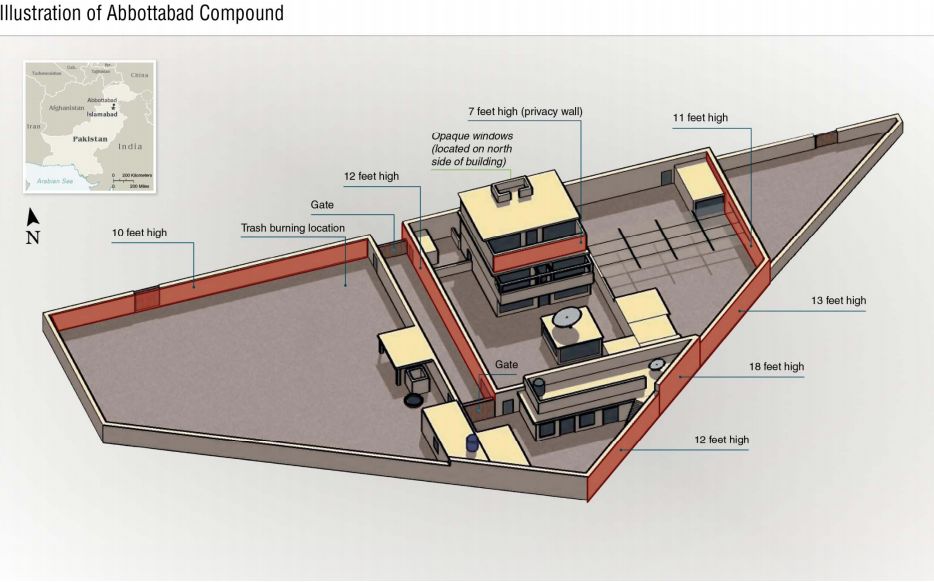
Vickers also told the filmmakers that outside of CIA, NSA, and NGA "there were like eight or nine people … who actually knew about" the planning of
the raid in the fall of 2010. The Secretary of State was informed "a couple of weeks before."
Among the collection is a June 15, 2011, email from Deputy National Security Advisor for Strategic Communications Benjamin Rhodes to Assistant Secretary of
Defense for Public Affairs Doug Wilson, stating: "we are trying to have visibility into the UBL projects and this is likely the most high profile one.
Would like to have whatever group is going around in here at the WH [White House] to get a sense of what they're doing / what cooperation they're seeking."
Other emails illustrating the extensive level of access provided to the filmmakers include a July 13, 2011, message from Mark Boal's assistant to CIA
spokesperson Marie Harf asking for specifics on the compound's floor plan, and yet another from July 20, 2011, from CIA Director of Public Affairs George
Little to Boal saying, "I can't tell you how excited we all are (at DOD and CIA) about the project … PS - I want you to know how good I've been not
mentioning the premiere tickets. :)"
The film project also had the "full knowledge and full approval/support" of CIA Director Leon Panetta, and received a 40-minute meeting with Deputy
Director Mike Morell, in which he "talked some of the substance again, told them we're here to help with whatever they need, and gushed Kathryn about how
much he loved [their previous film] 'the hurt locker.'" They also received "context briefings" from Vickers.
Most interestingly, the DOD and CIA
disclosed the identities
of five CIA and military operatives -including the translator present at the raid- to Bigelow and Boal, but claims those identities can only be disclosed
to selected film makers, not to other interested members of the public.
The documents do not include any copies of CIA nondisclosure agreements or releases signed by Bigelow or Boal; however, one CIA email details unspecified
"ridiculous bureaucratic hiccups" and redacts the content of an "ogc" [Office of General Counsel] ruling on Bigelow and Boal. The filmmakers did, however,
provide the CIA with releases for their employees to sign.
The special cooperation afforded the ZD30 production team stands in contrast to recent DOD and DOJ handling of individuals in related
circumstances. In August 2012, the Department of Defense wrote a letter to former Navy SEAL "Mark Owen" who was publishing his firsthand account of the
raid, No Easy Day. The Pentagon warned that he was "in material breach and violation" of his non-disclosure agreements and that the DOD was
"considering pursuing against you, and all those acting in concert with you, all remedies legally available to us in light of this situation."
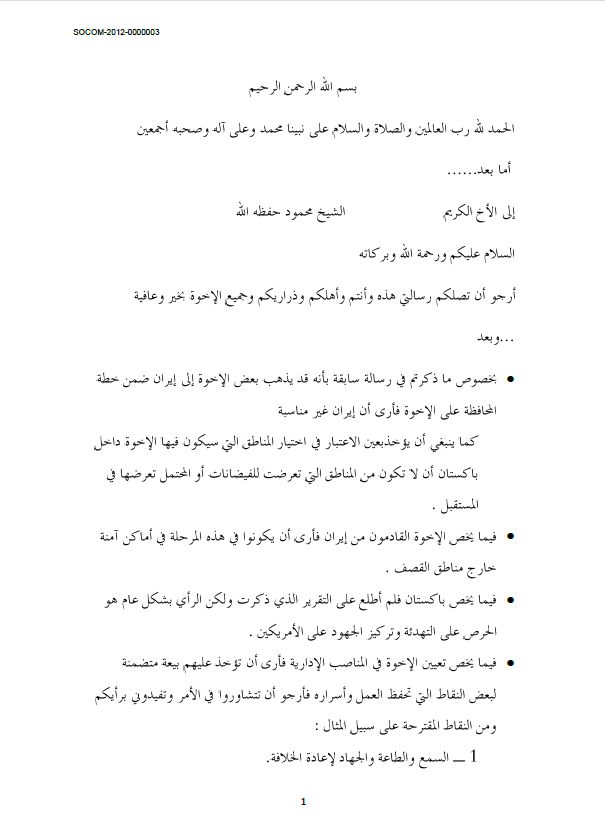
Section of a letter, assumed to be from bin Laden to Shaykh Mahmud.
In November 2012, seven SEALs who participated in the raid were reprimanded for disclosing classified material as
paid consultants for a video game entitled, "Medal of Honor: War fighter." They received a punitive letter of reprimand and were docked half pay for two
months. The Zero Dark Thirty website contains a link urging viewers to "Get the Zero Dark Thirty Map Pack NOW!" for Medal of Honor Warfighter
-perhaps one or more of the SEALSs were among ZD30's sources.
In December 2012 the Department of Defense confirmed that Vickers was the subject of a DOD
Inspector General Investigation "on the question of whether Mr. Vickers provided classified information in an interview with the filmmakers."
It is plausible that senior administration officials with the authority to declassify information legally gave Bigelow and Boal details of the raid; it is
also possible that -as some Republicans have claimed- officials improperly and selectively leaked information to portray the administration in a flattering
light.
In any case, at the same time that the Obama administration was giving presumably classified details of the UBL raid to its chosen film production team,
its Department of Justice has been persecuting leakers and whistleblowers at an
unprecedented rate, using the 1917 Espionage Act to indict six individuals for disclosing allegedly classified information critical of the U.S. government
to journalists.
Document 17B
"Transcript from Background Interview with Mark Boal and Kathryn Bigelow," July 15, 2011, from Judicial Watch v. U.S. Department of Defense
(No. 1:12-cv-00049), filed January 21, 2012, No Classification Indicated.
Source: http://www.judicialwatch.org/press-room/press-releases/judicial-watch-obtains-4-to-5-inch-stack-of-overlooked-cia-records-detailing-meetings-with-bin-laden-filmmakers/
This extensive, 16-page transcript of Under Secretary of Defense for Intelligence Michael Vickers' interview with Bigelow and Boal is a highlight of the
larger package of FOIA documents above (Document 17). It features detailed descriptions of the bin Laden mission, including its planning and the existence
of intelligence uncertainties (40 percent, 60 percent, 95 percent) over whether bin Laden himself was at the compound.
Document 18A, 18B
Judicial Watch, Inc., v United States Department of Defense and Central Intelligence Agency"
Appeal to the U.S. Court of Appeals for the D.C. Circuit, Filed November 29, 2012, with attached Declaration of John Bennett, Director of CIA's National Clandestine Service, September 26, 2011, Unclassified.
The Department of Justice has claimed that photographs and videos of the UBL raid were properly classified and should not be released to the public.
President Obama
has stated
that he did not want the photos of a deceased Osama bin Laden "floating around as an incitement to additional violence or as a propaganda tool."
John Bennett, Director of the CIA's National Clandestine Service, wrote in a declaration that "the responsive records would provide terrorist groups and
other entities hostile to the United States with information to create propaganda which, in turn, could be used to recruit, raise funds, inflame tensions,
or rally support for causes and actions that reasonably could be expected to result in exceptionally grave damage to both the national defense and foreign
relations of the United States."
The Department of Defense, whose Navy SEALs conducted the raid, told Judicial Watch that it could find no responsive documents to their FOIA request. The
Central Intelligence Agency has found 52 responsive records, all of which, it claims, must be withheld under the FOIA's b(1) and b(3) exemptions. In a separate case, the Associated Press filed a FOIA
request for photographs of the deceased bin Laden. The Department of Defense responded that it could find no documents, a decision which the AP is
appealing administratively. The Central Intelligence Agency has not yet responded to the AP's May 2011 request.
Document 19A, 19B
"Letters from Senators McCain, Feinstein, and Levin to Acting CIA Director Michael Morell," December 2012, http://www.feinstein.senate.gov,
Unclassified.
Senators John McCain, Dianne Feinstein, and Carl Levin co-authored two letters to Acting CIA Director Michael Morell concerning information the CIA
provided to Zero Dark Thirty filmmakers Kathryn Bigelow and Mark Boal. The first letter, sent December 19, 2012, expresses concern that the CIA
had misled the filmmakers, "given the CIA's cooperation with the filmmakers and the narrative's consistency with past public misstatements by former senior
CIA officials."
The second letter, issued December 31, 2012, asks Morell to clarify his December 21, 2012, statement to CIA employees, in which he claimed, "Some
[information regarding Osama bin Laden's location] came from detainees subjected to enhanced techniques, but there were many other sources as well. And,
importantly, whether enhanced interrogation techniques were the only timely and effective way to obtain information from those detainees, as the film
suggests, is a matter of debate that cannot and never will be definitively resolved." The Senators ask the CIA director to clarify what role the
interrogation techniques played in finding bin Laden, and to verify the Senate Select Committee on Intelligence's Study of the CIA's Detention and
Interrogation program findings, that "[t]he CIA detainee who provided the most accurate information about the courier provided the information prior to being subjected to coercive interrogation techniques." (Emphasis in original.)
|

